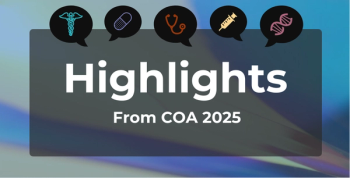
Dr Ajai Chari: Patients in High-risk Subgroups Benefited From Daratumumab Plus Triplet
Ajai Chari, MD, professor of medicine and director of clinical research in the Multiple Myeloma Program at Mount Sinai in New York, discusses a post-hoc analysis of data from the phase 2 GRIFFIN trial.
Evidence-Based OncologyTM (EBO) spoke with
GRIFFIN showed that patients with newly diagnosed, transplant-eligible
Data that Chari presented at ASH involved key groups: patients older and younger than 65 years of age and certain high-risk patients, including stage III patients as defined by the International Staging System; patients with certain high cytogenic risk; and patients with certain high-risk chromosomal abnormalities.2
This interview is edited lightly for clarity.
EBO: Can you summarize the post-hoc analysis of the final results from the GRIFFIN study that were presented during ASH and how they build on prior results?
CHARI: The GRIFFIN study is important because in the United States we were using RVd—lenalidomide, bortezomib, and dexamethasone, a triplet—for almost a decade before we had a randomized study. Now the question is: if 3 [therapies] are better than 2, are 4 better than 3?
In the past, sometimes that wasn’t the case; you added a fourth drug, and you got more side effects. Here, the question is: Is 4 better than 3? It’s a randomized study, unlike a single-arm study that we had [previously]. This study’s primary end point was the depth of response, which it met. It showed that the addition of daratumumab during induction consolidation, and for 2 years of maintenance, did lead to deepening of response. Surprisingly, even though it wasn’t the primary end point, it did also translate into progression-free survival (PFS), so that’s really exciting. I think for many of us who are early adopters, we’ve decided to adopt this quadruplet induction regimen, and it’s doing quite well. So, that’s the primary message from the study. Our update at this particular ASH meeting was really about the high-risk and elderly patients. I should mention elderly in the sense that they still got transplanted in the study—so it’s not frail elderly, but people aged over 65 and under 65 seem to have the same efficacy and safety profile. That was good to see. But perhaps the more juicy data from this was talking about the high-risk subgroups. What you can see is that when you look at [minimal residual disease] and PFS, almost everybody benefited from the addition of daratumumab with the notable exception of patients who had persistent disease after 2 years; meaning, these patients had less than a [very good partial response] and also extra-medullary disease. Other than that, everybody seemed to benefit with the addition of daratumumab.
EBO: What do these long-term results tell us about the importance of the initial upfront combination treatment in multiple myeloma?
CHARI: They confirm what we believed—that the addition of daratumumab leads to not only better responses, and we’re seeing that the response continues to deepen. As you give the daratumumab and lenalidomide in combination for 2 years, the responses deepen. And we’re seeing some of the flattest progression-free survival curves, and flat is getting us closer to cure. So, I think every incremental benefit we’re getting is making progress for our patients, because our best chance of getting a deep durable remission is really the first treatment. It’s really important, although I would add the caveat that it doesn’t mean everybody should be getting a quadruplet forever. I think it’s induction quad consolidation, and then just doublet maintenance for 2 years afterward...it kind of tapers off. And that’s really important, because I think sometimes people are a little hesitant to use an upfront anti-CD38 monoclonal antibody because they’re like, “Well, what am I going to do with relapse?” Here, you’re not doing it until they’re refractory to the drug, so there’s every reason why you should be able to reuse it if and when they relapse in the future.
EBO: Can it be argued that adding daratumumab up front to the standard triplet is superior from a cost-savings perspective, if it prevents the need for additional treatments in some patients?
CHARI: That answer is going to depend on longer-term data. Because right now, I think the maturity of the data is only about 3 years. I know during that time [we’ve been giving] the CD38 monoclonal antibody for almost 2 plus years. So, to see the value, you’re going to need to see, well, how much delay in the progression is there? And does that offset the upfront costs? I think we’ll need a longer follow-up to answer the cost question here.
EBO: What comes next in the study of this daratumumab combination in this group of patients with multiple myeloma?
CHARI: I think for global regulatory approval, we’ll need that randomized phase 3 [trial], which is called the PERSEUS study [
References
1. Laubach JP, Kaufman JL, Sborov DW, et al. Daratumumab (DARA) plus lenalidomide, bortezomib, and dexamethasone (RVd) in patients (pts) with transplant-eligible newly diagnosed multiple myeloma (NDMM): updated analysis of GRIFFIN after 24 months of maintenance. Blood. 2021;138(suppl 1):79. doi:10.1182/blood-2021-149024
2. Chari A, Kaufman JL, Laubach JP, et al. Daratumumab plus lenalidomide bortezomib, and dexamethasone (D-RVd) in transplant eligible newly diagnosed (NDMM) patients: final analysis of GRIFFIN among clinically relevant subgroups. Presented at: 64th American Society of Hematology Annual Meeting and Exposition; December 10-13, 2022; New Orleans, LA. Abstract 3238. https://ash.confex.com/ash/2022/webprogram/Paper162339.html
3. Moreau P, Hulin C, Perrot A, et al. Maintenance with daratumumab or observation following treatment with bortezomib, thalidomide, and dexamethasone with or with daratumumab and autologous stem-cell transplant in patients with newly diagnosed multiple myeloma (CASSIOPEIA): and open-label, randomised, phase 3 trial. Lancet Oncol. 2021;22(10):1378-1390. doi:10.1016/S1470-2045(21)00428-9
Newsletter
Stay ahead of policy, cost, and value—subscribe to AJMC for expert insights at the intersection of clinical care and health economics.







































